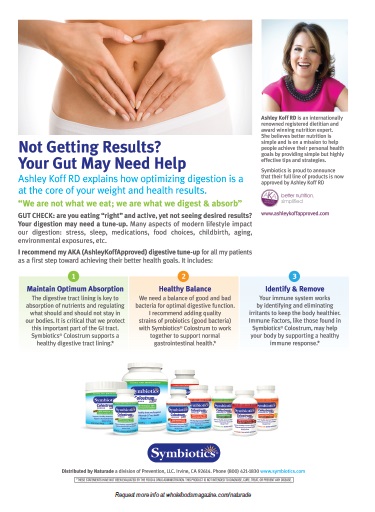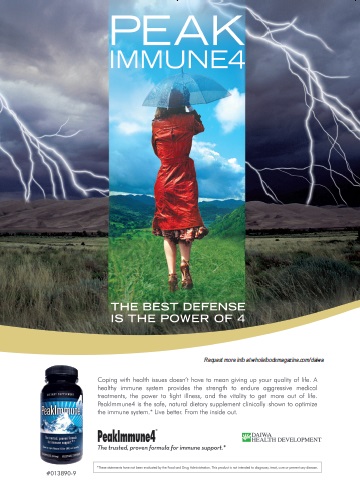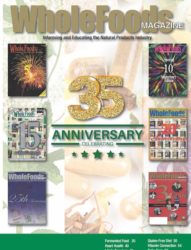 Supplement manufacturers typically deal in relatively general terms when marketing immune support products, according to Jay Levy, director of sales at Wakunaga of America Co., Ltd., Mission Viejo, CA. He notes that terms like “convenience” and “immune boosting” or “immune support” are used most often, without making any explicit disease benefit claims. “Most companies are careful to stick with structure/function claims while still using images and language designed to spark the consumer’s attention,” says Levy. This approach keeps companies on the right side of the U.S. Food and Drug Administration, he explains, though a small handful of companies may push the envelope with product benefit claims.
Supplement manufacturers typically deal in relatively general terms when marketing immune support products, according to Jay Levy, director of sales at Wakunaga of America Co., Ltd., Mission Viejo, CA. He notes that terms like “convenience” and “immune boosting” or “immune support” are used most often, without making any explicit disease benefit claims. “Most companies are careful to stick with structure/function claims while still using images and language designed to spark the consumer’s attention,” says Levy. This approach keeps companies on the right side of the U.S. Food and Drug Administration, he explains, though a small handful of companies may push the envelope with product benefit claims. Vitamin C usage spikes around back-to-school time and throughout the winter and early spring, says Gillespie. But she would like to see people remember to take their vitamin C all year, and simply increase their intake seasonally. She also says that products like vitamin D and probiotics are gaining wider adoption as year-round immune support options.
Vitamin C usage spikes around back-to-school time and throughout the winter and early spring, says Gillespie. But she would like to see people remember to take their vitamin C all year, and simply increase their intake seasonally. She also says that products like vitamin D and probiotics are gaining wider adoption as year-round immune support options.  Younger consumers such as millennials are particularly open to novel ingredients and flavors, Gillespie says, as long as they are convenient and taste good. An example of this phenomenon is the popularity of fermented foods and drinks like kombucha. Similarly, she says that her company’s vitamin C booster powder is popular as an add-in for smoothies.
Younger consumers such as millennials are particularly open to novel ingredients and flavors, Gillespie says, as long as they are convenient and taste good. An example of this phenomenon is the popularity of fermented foods and drinks like kombucha. Similarly, she says that her company’s vitamin C booster powder is popular as an add-in for smoothies. These negative immune health consequences are thought to be triggered by the release of stress hormones, namely cortisol and adrenaline, explains Eliaz. These hormones negatively impact the production of protective antibodies and disease-fighting immune cells. “In addition, intense training increases inflammation and oxidative stress which also suppress immunity,” Eliaz says.
These negative immune health consequences are thought to be triggered by the release of stress hormones, namely cortisol and adrenaline, explains Eliaz. These hormones negatively impact the production of protective antibodies and disease-fighting immune cells. “In addition, intense training increases inflammation and oxidative stress which also suppress immunity,” Eliaz says. Probiotics can help give high-endurance athletes a needed boost, according to Martoni. He describes one of his company’s formulas, which straddles the sports nutrition and immune support markets. It combines the probiotic strains Lactobacillus acidophilus DDS-1 and Bifidobacterium lactis BL-04, the latter of which he says has been found to support healthy immune function in athletes. The formula also contains betaine and vitamin D3, he adds.
Probiotics can help give high-endurance athletes a needed boost, according to Martoni. He describes one of his company’s formulas, which straddles the sports nutrition and immune support markets. It combines the probiotic strains Lactobacillus acidophilus DDS-1 and Bifidobacterium lactis BL-04, the latter of which he says has been found to support healthy immune function in athletes. The formula also contains betaine and vitamin D3, he adds.|
Extraction Action Supplement companies dealing in botanicals or mushrooms have to figure out how best to deliver active beneficial compounds in their products. One of the most pivotal decisions in this process is the extraction method. Some nutrients that support immunity are better collected from the whole herb by using one extraction method over another. Isaac Eliaz, MD, MS, LAc., medical director of Amitabha Medical Clinic and founder of ecoNugenics, Inc., Santa Rosa, CA, says that herbs contain hundreds of  compounds, and some are water soluble (hydrophilic) while others are primarily fat soluble (lipophilic). compounds, and some are water soluble (hydrophilic) while others are primarily fat soluble (lipophilic).The proper solvent needs to be used to most efficiently extract each type of compound, says Eliaz. The extraction method must be selected with careful consideration for which active ingredients are to be emphasized in the end product. He says that his company conducts extensive research when formulating products to ensure that the extracts being used contain the appropriate active compounds. Many extracts available on the market are standardized to a particular concentration of active compounds to ensure consistency, Eliaz notes. “Hot water extraction is a traditional method for processing mushrooms and we follow this procedure for the majority of our mushroom extracts,” says Jeff Chilton, president and founder of Nammex, Gibsons, BC, Canada. Some mushrooms, like reishi and chaga, have important compounds for which water extraction is not ideal. Chilton says that in those cases, water extraction is followed with ethanol extraction. Using this dual extraction method assures the complete removal of the active compounds from the fibrous cell walls. Chilton believes shoppers should look carefully at supplement facts panels to see which plant part has been used and how the active compounds stack up to those in other products. Beyond alcohol vs. water solubility, Sandra Carter, MPH, Ph.D., founder of Mushroom Matrix, Carlsbad, CA, notes several other characteristics of the active compounds in mushrooms that supplement makers must consider. Some compounds prove to be insoluble, while others have varying degrees of sensitivity to temperature. “In the world of medicinal mushrooms and herbs, there are two basic approaches as to how to best process and use the products,” says Carter. One involves isolating and concentrating one or two active ingredients. As a consequence of the extraction process, other compounds not deemed necessary to the formula are discarded. The other approach, Carter says, focuses on harvesting and preparing the whole herb or mushroom and all of its nutritional compounds. The goal is for the acids, enzymes and probiotics in our digestive tracts to carry out the “extraction” and for the body to select the nutrients it needs. Carter says her company embraces the “whole food” concept with its mushroom products. There are compromises involved in either approach, she says. For example, unextracted mushroom products require larger daily doses than extracted products. |
 nd its primary role in breaking down waste and helping to absorb vitamins and minerals. B. lactis has been found to help reduce intestinal permeability, improve oral health by fighting dental cavities and enhance immunity by reducing the frequency and severity of respiratory conditions, according to Crum.
nd its primary role in breaking down waste and helping to absorb vitamins and minerals. B. lactis has been found to help reduce intestinal permeability, improve oral health by fighting dental cavities and enhance immunity by reducing the frequency and severity of respiratory conditions, according to Crum.
 e explains that this breakthrough comes at a time when mushrooms are finally gaining mainstream acceptance. This makes it all the more important, he believes, for mushroom supplements to be fully supported by scientific quality control standards. Proper labeling of medicinal mushrooms is important, Chilton argues, because different preparations have different levels of active compounds. Choice of cultivation method, he says, can directly impact beta-glucan production.
e explains that this breakthrough comes at a time when mushrooms are finally gaining mainstream acceptance. This makes it all the more important, he believes, for mushroom supplements to be fully supported by scientific quality control standards. Proper labeling of medicinal mushrooms is important, Chilton argues, because different preparations have different levels of active compounds. Choice of cultivation method, he says, can directly impact beta-glucan production.1. Z. Ahmadinejad, et al., “Common Sports-related Infections: A Review on Clinical Pictures, Management and Time to Return to Sports,” Asian J Sports Med. 5(1):1-9 (2014).
2. B.K. McFarlin, et al., “Baker’s Yeast Beta Glucan Supplementation Increase Salivary IgA and Decreases Cold/Flu Symptomatic Days After Intense Exercise,” Journal of Dietary Supplements 10:171-183 (2013).
3. S. McKinley-Barnard, et al., “Combined L-citrulline and Glutathione Supplementation Increases the Concentration of Markers Indicative of Nitric Oxide Synthesis,” J. Int. Soc. Sports Nutr. 12:27 (2015).
4. S.J. Spaiser, et al., “Lactobacillus gasseri KS-13, Bifidobacterium bifidum G9-1, and Bifidobacterium longum MM-2 Ingestion Induces a Less Inflammatory Cytokine Profile and a Potentially Beneficial Shift in Gut Microbiota in Older Adults: A Randomized, Double-Blind, Placebo-Controlled, Crossover Study,” J. Am. Coll. Nutr. 24:1-11 (2015) [Epub ahead of print].
5. M.P. Nantz, et al. “Supplementation with Aged Garlic Extract Improves both NK and gamma delta T cell Function and Reduces the Severity of Cold and Flu Symptoms: A Randomized, Double-Blind, Placebo-Controlled Nutrition Intervention,” 31:337-344 (2012).
6. M. Kolatsi-Joannou, et al. “Modified citrus pectin reduces galectin-3 expression and disease severity in experimental acute kidney injury,” PLoS One 6(4):e18683 (2011).
7. L. Vannucci, et al. “Immunostimulatory Properties and Antitumor Activities of Glucans (Review),” Int. J. Oncol. 43:357-364 (2013).
8. Noelia Alonso, Eliana et al. “Genes Related to Suppression of Malignant Phenotype Induced by Maitake D-Fraction in Breast Cancer Cells,” J Med Food 16 (7):602–617 (2013)











